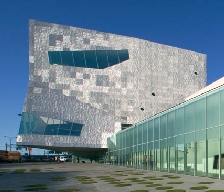art: Rothko coolly torches SFMOMA
 SFMOMA's Rothko (No. 14, 1960) quietly overpowers everything else in the museum. It's not the Titanic, it's the iceberg that sank the Titanic. It's suffused with pure emotion, but it's a receding internal burn. The red is alive but not fiery; the mouth (or dot of the exclamation point?) underneath is a deep inky blue but it's not heavy, you can see through it to the background of quiet earth. The brushwork is sensationally good. Ten feet tall, it's bigger than you but it's taking emotional states available to everyone and exalting them to a mystical, noble level. Duchamp invented so much, Picasso and Matisse were big stars, but in 2200 I'm confident people will rank Rothko higher than any other artist of the 20th century.
SFMOMA's Rothko (No. 14, 1960) quietly overpowers everything else in the museum. It's not the Titanic, it's the iceberg that sank the Titanic. It's suffused with pure emotion, but it's a receding internal burn. The red is alive but not fiery; the mouth (or dot of the exclamation point?) underneath is a deep inky blue but it's not heavy, you can see through it to the background of quiet earth. The brushwork is sensationally good. Ten feet tall, it's bigger than you but it's taking emotional states available to everyone and exalting them to a mystical, noble level. Duchamp invented so much, Picasso and Matisse were big stars, but in 2200 I'm confident people will rank Rothko higher than any other artist of the 20th century.
Rothko painted a similar design in 1961's Number 207, it's brighter on darker and blacker. The canvas is burning up:

Labels: art





 From the right angle the windows cut into the new square tower make it look exactly like a Rock 'Em Sock 'Em Robot. Rarrrr!
From the right angle the windows cut into the new square tower make it look exactly like a Rock 'Em Sock 'Em Robot. Rarrrr! Jhane with the
Jhane with the 





 So many great designs,
So many great designs, 

